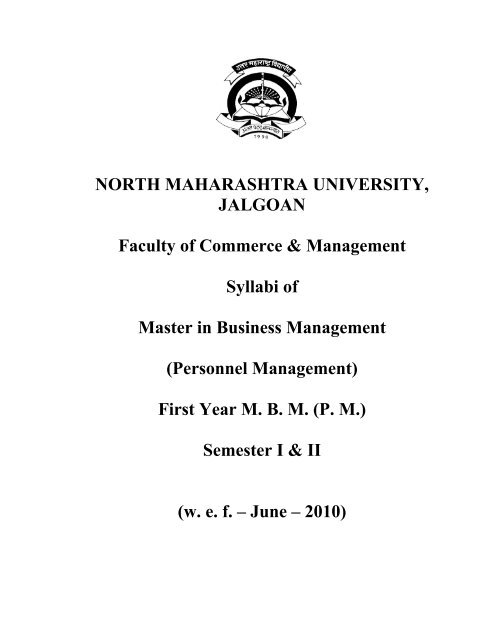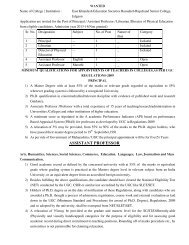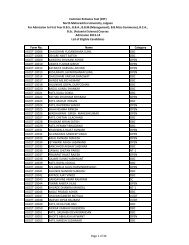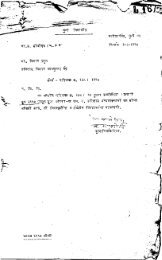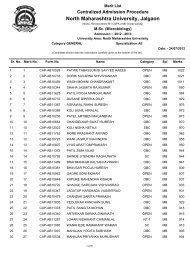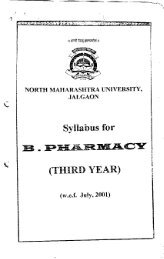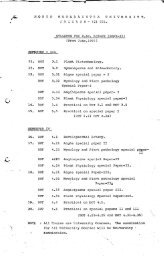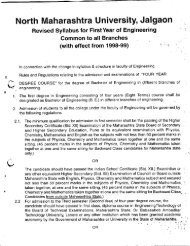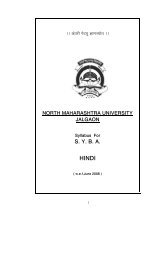NORTH MAHARASHTRA UNIVERSITY, JALGOAN Faculty of ...
NORTH MAHARASHTRA UNIVERSITY, JALGOAN Faculty of ...
NORTH MAHARASHTRA UNIVERSITY, JALGOAN Faculty of ...
You also want an ePaper? Increase the reach of your titles
YUMPU automatically turns print PDFs into web optimized ePapers that Google loves.
<strong>NORTH</strong> <strong>MAHARASHTRA</strong> <strong>UNIVERSITY</strong>,<br />
<strong>JALGOAN</strong><br />
<strong>Faculty</strong> <strong>of</strong> Commerce & Management<br />
Syllabi <strong>of</strong><br />
Master in Business Management<br />
(Personnel Management)<br />
First Year M. B. M. (P. M.)<br />
Semester I & II<br />
(w. e. f. – June – 2010)
<strong>NORTH</strong> <strong>MAHARASHTRA</strong> <strong>UNIVERSITY</strong>, JALGAON<br />
<strong>Faculty</strong> <strong>of</strong> Commerce & Management<br />
New Syllabus: MBM (P.M.) (W.E.F. June -2010)<br />
Semester: I<br />
Subject Code No.1.1<br />
PRINCIPLES AND PRACTICES OF MANAGEMENT<br />
(Compulsory Paper)<br />
60+40 Pattern: External Marks 60 +Internal Marks 40 = Maximum Total marks: 100<br />
Total Lectures Allotted: 50<br />
CHAPTER 1- Introduction to Management<br />
a) Definition, Nature , Scope, Functions<br />
b) Process <strong>of</strong> Mgt.<br />
Planning- Need & Steps in Planning<br />
Organizing- Importance & Structure <strong>of</strong> org.<br />
Directing - Meaning & principles<br />
Co-ordination- Need & importance<br />
c) Mgt. & Administration, MBO, Span <strong>of</strong> Mgt.,<br />
Delegation <strong>of</strong> Authority.<br />
CHAPTER 2- Managing & Managers<br />
d) Why study org. & Mgt.<br />
e) Efficiency & Effectiveness<br />
f) Mgt. Levels & Skills<br />
g) Need for vision, ethics & responsiveness to culture diversity.<br />
CHAPTER 3- Contribution <strong>of</strong> Mgt. thinker<br />
a) F. W. Taylor, Henry Fayol, Max Weber, C. Bernard<br />
CHAPTER 4- Mgt. in 21 century<br />
a) Liberalization, Privatization, Globalization<br />
b) Japanese Mgt., American Mgt.<br />
c) ISO certification , Environment friendly packaging ,<br />
Culture & multi cultural.<br />
d) JIT, TQM.s
Reference Books :<br />
1) Principles & practice <strong>of</strong> Management – Dr. Sakhtiwal Murgan, New Age Int.<br />
Publications<br />
2) Principles & practice <strong>of</strong> Management – L.M.Prasad, Sultan chand & sons.<br />
3) Principles <strong>of</strong> Management – T.Ramasamy, Himalaya Publishing House<br />
4) Management 6 th Edition- James A.F. Stoner, R. Edward, Daniel R.,<br />
Prentice- Hall India
<strong>NORTH</strong> <strong>MAHARASHTRA</strong> <strong>UNIVERSITY</strong>, JALGAON<br />
<strong>Faculty</strong> <strong>of</strong> Commerce & Management<br />
New Syllabus: MBM (P.M.) (W.E.F. June -2010)<br />
Semester: I<br />
Subject Code No.1.2<br />
INDUSTRIAL PSYCHOLOGY & SOCIOLOGY<br />
(Compulsory Paper)<br />
60+40 Pattern: External Marks 60 +Internal Marks 40 = Maximum Total marks: 100<br />
Total Lectures Allotted: 50<br />
* Industrial Psychology<br />
Chapter 1 – Industrial Psychology (No. <strong>of</strong> lec-6)<br />
Concept- A branch <strong>of</strong> practical psychology,<br />
Objective, development, scope, problems,<br />
Function & values <strong>of</strong> Industrial psychology<br />
Chapter 2 –Psychological Test (No. <strong>of</strong> lec-8)<br />
Concept, Characteristics <strong>of</strong> good test, Who make decision from Test & how? Types <strong>of</strong><br />
test<br />
i. Ability Test<br />
ii. Personality test<br />
iii. Intelligence test<br />
iv. Attitude test<br />
Chapter 3 – Human Relations (No. <strong>of</strong> lec-10)<br />
Definition, objective, Nature, scope <strong>of</strong> Human Relations<br />
Philosophy <strong>of</strong> Human Relations<br />
Basic themes in Human Relation<br />
Criticism <strong>of</strong> Human Relations Approach<br />
Fundamentals <strong>of</strong> motivation,<br />
Behavioural effectiveness- communicating for effectiveness,<br />
International Human Relations,<br />
Human Relations challenges <strong>of</strong> the future<br />
* Industrial Sociology<br />
Chapter 1 –Industrial Sociology (No. <strong>of</strong> lec-3)<br />
Meaning, nature, scope & significance
Chapter 2 – (No. <strong>of</strong> lec-4)<br />
Emergence <strong>of</strong> Industrial society, factory as social organization, organizational<br />
development<br />
Chapter 3 – (No. <strong>of</strong> lec-5)<br />
Industrial Bureaucracy, problems in Bureaucracy<br />
Chapter 4 – (No. <strong>of</strong> lec-6)<br />
The working environment, Impact <strong>of</strong> automation, computerization, rationalization,<br />
specialization and technological change in work organization and society<br />
Chapter 5 – (No. <strong>of</strong> lec-6)<br />
Industrialization and social institution in India<br />
Reference Books :<br />
1) Introduction to psychology – Clifford T. Morgan, Tata McGRAW- HILL<br />
2) Social Psychology –Robert Baron , Donn Byrne, Nyla Branscombe<br />
3) Human Relation- Tata McGRAW- HILL
<strong>NORTH</strong> <strong>MAHARASHTRA</strong> <strong>UNIVERSITY</strong>, JALGAON<br />
<strong>Faculty</strong> <strong>of</strong> Commerce & Management<br />
New Syllabus: MBM (P.M.) (W.E.F. June -2010)<br />
Semester: I<br />
Subject Code No.1.3<br />
INDUSTRIAL ECONOMICS<br />
(Compulsory Paper)<br />
60+40 Pattern: External Marks 60 +Internal Marks 40 = Maximum Total marks: 100<br />
Total Lectures Allotted: 50<br />
Chapter 1 – Introduction to Industrial development in India (No. <strong>of</strong> lec-5)<br />
a) Indian industries during Pre-independence period<br />
b) Emergence <strong>of</strong> Modern Industries in India<br />
Chapter 2 – Indian Industrial System (No. <strong>of</strong>lec-8)<br />
a) Small-scale, Cottage & Village Industries<br />
b) Manufacturing & Service industries<br />
c) Government intervention, regulation & control<br />
d) Location patterns <strong>of</strong> Industries in India : Developed & Undeveloped areas<br />
e) Problems <strong>of</strong> Industries : Manufacturing industries & Services industries<br />
Chapter 3 – Role <strong>of</strong> Financial Institutions & Intermediaries (No. <strong>of</strong> lec-8)<br />
a) NBFC<br />
b) Co-operative bank<br />
c) Public & Private banks<br />
d) Financial Institutions – IFCI, IDFC, IRBI, SFIs, BIFR<br />
Chapter 4 – Role <strong>of</strong> Foreign Capital (No. <strong>of</strong> lec-5)<br />
a) Types <strong>of</strong> Foreign Capital<br />
b) MNC & Indian Foreign collaboration<br />
c) Foreign Investment in recent years (from 2007 onwards)<br />
d) Government Policy in regards to Foreign Capital<br />
e) Role <strong>of</strong> Foreign Investment in Public & Private sector<br />
Chapter 5 – Industrial sickness (No. <strong>of</strong> lec-5)<br />
a) Extent <strong>of</strong> Industrial sickness in India<br />
b) Causes <strong>of</strong> Industrial sickness<br />
c) Government Policy in regards to Industrial sickness
Chapter 6 – Indian Industries & Energy problem (No. <strong>of</strong> lec-5)<br />
a) Nature <strong>of</strong> Energy problem in India<br />
b) Energy Crisis & Measures to solve energy problems<br />
Chapter 7 – Industrial Productivity (No. <strong>of</strong> lec-5)<br />
a) Importance <strong>of</strong> Productivity Analysis<br />
b) Factors influencing Industrial Productivity<br />
Chapter 8 – India’s Foreign Trade (No. <strong>of</strong> lec-8)<br />
a) Importance <strong>of</strong> Foreign Trade for a developing country<br />
b) Provisions <strong>of</strong> WTO & its effects on Industries in India<br />
c) Recent Export-Import Policy <strong>of</strong> India<br />
Reference Books :<br />
4) Industrial Economics – R.R.Barthwal, New Age Intl Publications<br />
5) Industrial Economy <strong>of</strong> India – S.S.M.Desai & K.Bhalerao<br />
6) Indian Economy – Rudra Dutt & Sundaram ,<br />
7) Indian Economy- A. N. Agrawal, New age international Publication
<strong>NORTH</strong> <strong>MAHARASHTRA</strong> <strong>UNIVERSITY</strong>, JALGAON<br />
<strong>Faculty</strong> <strong>of</strong> Commerce & Management<br />
New Syllabus: MBM (P.M.) (W.E.F. June -2010)<br />
Semester: I<br />
Subject Code No.1.4<br />
PERSONNEL ADMINISTRATION AND MANAGEMENT<br />
(Compulsory Paper)<br />
60+40 Pattern: External Marks 60 +Internal Marks 40 = Maximum Total marks: 100<br />
Total Lectures Allotted: 50<br />
CHAPTER I- Introduction to personnel management: 6<br />
a)Nature, Objectives, scope, Importance.<br />
b) Personnel management functions in India<br />
c) Personnel Manager: Qualifications, Role, Functions,Qualities.<br />
CHAPTER II- Development <strong>of</strong> Personnel management: 4<br />
‐ Historical Development<br />
‐ Personnel practices in Indian Industries<br />
‐ Code <strong>of</strong> ethics <strong>of</strong> members <strong>of</strong> National Institute <strong>of</strong> personnel Management.<br />
CHAPTER III- Introduction to personnel Administration 12<br />
- Meaning , Definition, Scope, Importance<br />
- Organisational structure <strong>of</strong> personnel department<br />
- Personnel policies, procedures and programmes<br />
- Personnel records and documentations<br />
a) Personnel records- types<br />
b) Objectives <strong>of</strong> record system<br />
c) Technique and styles <strong>of</strong> record keeping<br />
d) Essentials <strong>of</strong> effective record keeping,<br />
- personnel reports;<br />
a) Essentials <strong>of</strong> good report<br />
b) Types <strong>of</strong> reports<br />
CHAPTER IV- Compensation Management: 8<br />
‐ Meaning and types <strong>of</strong> compensation policies<br />
‐ Preparing good wage plan<br />
‐ Wage differentials- importance, Indian scenario
CHAPTER V- Recruitment selection placement and Induction 6<br />
1) –Recruitment: Definition and meaning<br />
-Elements <strong>of</strong> good recruitment policy<br />
-Sources <strong>of</strong> recruitment<br />
-Recruitment practices in India<br />
2) Selection procedures<br />
-Barriers <strong>of</strong> effective selection<br />
3)Placement and employee engagement<br />
- principles <strong>of</strong> effective placements<br />
4) Induction- Meaning , elements<br />
induction practices and policies<br />
-Requisites <strong>of</strong> good induction program<br />
CHAPTER VI- Job changes 5<br />
a) -Promotion- Definition, principles , procedures<br />
- Objective and types <strong>of</strong> promotion policies<br />
- role <strong>of</strong> personnel department in promotion<br />
b)-Demotion- causes, regulations<br />
-policies <strong>of</strong> demotion<br />
c)- transfer- nature, objectives<br />
- transfer policies and procedures<br />
CHAPTER VII-Performance appraisal & Merit Rating<br />
a) Performance appraisal objectives ,Approaches, Typical Appraisal Summary,<br />
Importance, Limitations, Organisational Uses ,Components <strong>of</strong> Appraisal Evaluation.<br />
b) Merit Rating- introduction, Merit Rating & Job Evaluation. 3<br />
CHAPTER VIII- Personnel problems<br />
in public and private organisations,co-operative and IT sector 3
Reference Books :<br />
1) Personnel Management Vol 1,2,3- Arunkumar & Rachana sharma,<br />
Mangaldeep<br />
2) Personnel Management- C. B. Mamoria, Himalaya Publication<br />
3) Personnel Management- A.M. Sharma- Himalaya Publication<br />
4) Human Resource Management- V. S. P. Rao- Excel<br />
5) Human Resource Management- S.S. Khanka, Schand & sons<br />
6) Essentials <strong>of</strong> HRM- V.S.P.Rao, Excel<br />
7) Human Resource Management- K. Aswathappa, Tata McGraw
<strong>NORTH</strong> <strong>MAHARASHTRA</strong> <strong>UNIVERSITY</strong>, JALGAON<br />
<strong>Faculty</strong> <strong>of</strong> Commerce & Management<br />
New Syllabus: MBM (P.M.) (W.E.F. June -2010)<br />
Semester: I<br />
Subject Code No.1.5<br />
LAWS FOR WAGES & WORKING CONDITIONS<br />
(Compulsory Paper)<br />
60+40 Pattern: External Marks 60 +Internal Marks 40 = Maximum Total marks: 100<br />
Total Lectures Allotted: 50<br />
Chapter-1 Introduction 03<br />
i. Meaning <strong>of</strong> Labour Legislation<br />
ii. Need for Labour Legislation<br />
iii. Principles <strong>of</strong> Labour Legislation<br />
iv. Objectives <strong>of</strong> Labour Legislation<br />
Chapter-2 The Payment <strong>of</strong> Wages Act, 1936 08<br />
i. Meaning <strong>of</strong> Wages<br />
ii. Types <strong>of</strong> Wages<br />
iii. Features <strong>of</strong> Wage policy<br />
iv. Factors affecting Wages<br />
Chapter-3 Minimum Wages Act, 1948 07<br />
Chapter-4 Payment <strong>of</strong> Bonus Act, 1965 08<br />
Chapter-5 The Equal Remuneration Act, 1976 08<br />
Chapter-6 Factories Act, 1948 08<br />
Chapter-7 Contract Labour (Regulation and abolition) Act, 1970 08<br />
REFERENCE BOOKS:-<br />
1. Labour Industrial laws- Dr.V.G.Goswami, Central Law Agency.<br />
2. Labour Laws- Taxmann, Taxmann.<br />
3. Labour Law- S. D. Geet, Nirali Prakashan<br />
4. Industrial Relations – T. N. Chhabra, R. K. Suri, Dhanpat Rai & co.<br />
5. Labour Laws for managers- B. D. Singh, Excel<br />
6. Industrial Jurisprudence & L.L.- A. M. Sarma, Himalaya Publication
<strong>NORTH</strong> <strong>MAHARASHTRA</strong> <strong>UNIVERSITY</strong>, JALGAON<br />
<strong>Faculty</strong> <strong>of</strong> Commerce & Management<br />
New Syllabus: MBM (P.M.) (W.E.F. June -2010)<br />
Semester: I<br />
Subject Code No.1.6<br />
Computer Fundamentals and Office Automation (Compulsory Paper)<br />
60+40 Pattern: External Marks 60 +Internal Marks 40 = Maximum Total marks: 100<br />
Total Lectures Allotted: 50<br />
Characteristics <strong>of</strong> modern computer (2)<br />
a. Hardware requirements<br />
b. S<strong>of</strong>tware requirements<br />
2. Introduction to hardware and S<strong>of</strong>tware (5)<br />
a. Types <strong>of</strong> s<strong>of</strong>tware – System s<strong>of</strong>tware, Application s<strong>of</strong>tware<br />
b. Types <strong>of</strong> Operating system – characteristics, comparison <strong>of</strong> the features <strong>of</strong><br />
operating system, examples <strong>of</strong> operating system<br />
c. Hardware - scanner, printer, barcode reader, biometrics, fax handling<br />
d. Network – LAN, WAN, MAN, modem, switches, hub<br />
3. File System (2)<br />
a. windows environment, file manager, searching a file, security in windows<br />
4. Modern Systems (3)<br />
a. Introduction to latest terminology – freeware, open source, outsourcing,<br />
BPO, ERP, CRM<br />
b. Zip and unzip files<br />
c. Editing pdf files<br />
MS-OFFICE 2007<br />
• Word 2007 (12)<br />
a. Creating a new document, opening and saving a document<br />
b. Font and paragraph Formatting<br />
c. Copying and Moving Text and Object<br />
d. Tables<br />
e. Lists<br />
f. Page Formatting with borders and header & footer<br />
g. Inserting Graphics, Pictures, and Table <strong>of</strong> Contents<br />
h. Printing a document<br />
i. Mailmerge
• Excel 2007 (12)<br />
a. Opening a Blank or New Workbook, General Organization<br />
b. Basic Formulas and Use <strong>of</strong> built in Functions<br />
c. Working with Data: Entering, Editing, Copy, Cut, Paste, Paste Special<br />
d. Formatting Data and Using the Right Mouse Click<br />
e. Saving, Page Setup, and Printing<br />
f. Using Headers and Footers<br />
g. Manipulating Data using Data Names and Ranges, Filters and Sort, and<br />
Validation Lists<br />
h. Data from External Sources, Import and Export <strong>of</strong> data<br />
i. Using and Formatting Tables<br />
j. Data Analysis Using Charts and Graphs<br />
• PowerPoint 2007 (12)<br />
a. Creating a Basic Presentation<br />
b. Layouts in presentation<br />
c. Working with Text<br />
d. Working with Themes and Styles<br />
e. Working with Charts, Graphs, & Tables<br />
f. Working with Media Clips and Animation<br />
g. Hyperlink<br />
Reference Books:<br />
1. SAMS Teach Yourself Micros<strong>of</strong>t Office 2007- Greg Perry ISBN 0-672-32901-8<br />
2. Fundamentals <strong>of</strong> MS Office 2007 – Gretchen Douglas, Mark Connell<br />
3. How To Do Everything With Adobe Acrobat 7.0 - Doug Sahlin<br />
4. Adobe Acrobat 7.0 Quick Steps - Marty Matthews, John Cronan<br />
List <strong>of</strong> Practicals:<br />
1. File and folder handling in windows (copy, move, paste, secure). handling scanner,<br />
printer, fax, barcode reader<br />
2. Create and print a simple document<br />
3. Create a document with tables and formulas<br />
4. Create a letter using mailmerge<br />
5. Create a simple datasheet<br />
6. Manipulate data using data menu <strong>of</strong> MS Excel 2007
7. Create a data sheet and insert a chart<br />
8. Create a datasheet using multiple sheets in functions and formulas<br />
9. Create a simple presentation using different layouts and design<br />
10. Create a presentation using custom animation and slide transition<br />
11. Create presentation using hyperlinks<br />
12. Edit PDF files
<strong>NORTH</strong> <strong>MAHARASHTRA</strong> <strong>UNIVERSITY</strong>, JALGAON<br />
<strong>Faculty</strong> <strong>of</strong> Commerce & Management<br />
New Syllabus: MBM (P.M.) (W.E.F. June -2010)<br />
Semester: I<br />
Subject Code No.1.7<br />
FIELD WORK & VIVA-VOCE<br />
(Compulsory Paper)<br />
60+40 Pattern: External Marks 60 +Internal Marks 40 = Maximum Total marks: 100<br />
Total Lectures Allotted: 50<br />
1. Practical Training<br />
a) Compulsory Industrial Visit & study personnel department<br />
b) Study any one:-<br />
i. Visit to E.S.I. Corporation<br />
ii. Visit to P.F. <strong>of</strong>fice<br />
iii. Visit to Labour Commissioner Office<br />
iv. Visit to Employment Exchange Office<br />
v. Visit to Labour Court<br />
vi. Visit to Industrial Court
<strong>NORTH</strong> <strong>MAHARASHTRA</strong> <strong>UNIVERSITY</strong>, JALGAON<br />
<strong>Faculty</strong> <strong>of</strong> Commerce & Management<br />
New Syllabus: MBM (P.M.) (W.E.F. June -2010)<br />
Semester: I<br />
Subject Code No.1.8<br />
BUSINESS CORRESPONDENCE & COMMUNICATION SKILLS<br />
(Compulsory Paper)<br />
60+40 Pattern: External Marks 60 +Internal Marks 40 = Maximum Total marks: 100<br />
Total Lectures Allotted: 50<br />
2. Concept <strong>of</strong> Communication<br />
a) Meaning<br />
b) Process <strong>of</strong> Communication<br />
c) Objectives <strong>of</strong> communication<br />
d) Techniques <strong>of</strong> effective communication<br />
3. Types & Patterns <strong>of</strong> communication<br />
a) Upward Communication<br />
b) Downward Communication<br />
c) Consensus<br />
d) Formal & Informal Communication<br />
3. Methods <strong>of</strong> Communication<br />
a) Verbal<br />
b) Non Verbal<br />
4. Written Communication<br />
a) Qualities <strong>of</strong> good letter<br />
b) Layouts <strong>of</strong> business letters<br />
c) Writing different types <strong>of</strong> letters:-<br />
i. Enquiries & Replies<br />
ii. Orders & Replies<br />
iii. Complaints & Claims
iv. Sales Letters<br />
v. Application Letters<br />
vi. Reference letters / Testimonials<br />
vii. Reports writing<br />
d) Resume writing<br />
Reference Books:-<br />
1. Business communication for managers- Penrose, Rasberry, Myers, cenage<br />
Learning<br />
2. Business communication – Raman & Singh, oxford Publication<br />
3. Communication Today – Ruben Roy, Himalaya Publication<br />
4. Business communication- C. S. Raydu, Himalaya Publication<br />
5. Communication for Business- Taylor, Pearson Education<br />
6. Communication Skills- Dr. Rao & Dr. Das, Himalaya Publication<br />
7. Contemporary Business Communication- Scot Ober, Biztantra, Dreamtech<br />
8. Business communication Today- Bovee, Thill, Schatzman- Pearson<br />
9. Basics <strong>of</strong> Business communication- Lesikar & Flately, Tata Mc Graw Hills<br />
10. Business communication- R. K. Madhukar, Vikas Publication
<strong>NORTH</strong> <strong>MAHARASHTRA</strong> <strong>UNIVERSITY</strong>, JALGAON<br />
<strong>Faculty</strong> <strong>of</strong> Commerce & Management<br />
New Syllabus: MBM (P.M.) (W.E.F. June -2010)<br />
Semester: II<br />
Subject Code No.2.1<br />
ORGANISATION BEHAVIOUR<br />
(Compulsory Paper)<br />
60+40 Pattern: External Marks 60 +Internal Marks 40 = Maximum Total marks: 100<br />
Total Lectures Allotted: 50<br />
CHAPTER 1) Introduction (6)<br />
a) Definition <strong>of</strong> O.B<br />
b) Nature & Scope <strong>of</strong> O.B.<br />
c) influence <strong>of</strong> various disciplines on OB<br />
d) challenges and opportunities for O.B.<br />
CHAPTER 2) Individual Behavior (12)<br />
a) values – meaning, importance, types, relevance to OB<br />
b) Perception - Definition, Importance, Factors Influencing Perception, problems in<br />
Perception<br />
c) Personality - Concept. Determinants and Types<br />
d) learning – concept, Theories <strong>of</strong> Learning<br />
e) Attitudes - Types, Components & Functions. Attitudes& O.B.<br />
f) job satisfaction - Concept <strong>of</strong> Job Satisfaction, factors affecting job satisfaction, ways <strong>of</strong><br />
measuring it, job satisfaction & work performance<br />
CHAPTER 3) Group Dynamics (6)<br />
a) Groups in Organization, Nature, Membership, Process <strong>of</strong> Group Development, Types <strong>of</strong><br />
Groups<br />
b) Group Norms, Group Conformity, Group Cohesion, Group Size, Group Think, Group<br />
Shift.<br />
CHAPTER 4) Motivation (6)<br />
a) Meaning & Types <strong>of</strong> Motives<br />
b) Theories <strong>of</strong> Motivation<br />
i) Hierarchy <strong>of</strong> needs Theory<br />
ii) Theory X and Theory Y<br />
iii) Motivation‐Hygiene Two Factor theory<br />
iv) Vroom’s Expectancy theory<br />
c) Motivation applied ‐ Financial and non‐Financial motivators
CHAPTER 5) Leadership (6)<br />
a) Meaning , Functions, Styles <strong>of</strong> Leadership<br />
b) Theories <strong>of</strong> Leadership<br />
i.Fielders Leadership Contingency theory<br />
ii.Hersey‐Blanchards Situational Leadership Theory<br />
iii.Path Goal Theory<br />
iv.Charismatic Leadership Theory<br />
v.Transformation Leadership Theory<br />
vi.Ohio State Leadership Quadrants and Management Grids<br />
CHAPTER 6) Power & Conflicts (8)<br />
a) Meaning & Sources <strong>of</strong> Power<br />
b) Organisational Politics, factors causing Political behaviour<br />
c) Conflicts – Meaning, levels <strong>of</strong> Conflicts<br />
d) Intrapersonal Conflict ‐ Role Identity, Role Perception, Role Expectation, Role Conflict.<br />
e) Interpersonal Conflict (Transactional Analysis and Johari Window)<br />
f) Conflict Management<br />
CHAPTER 7) Change Management and Development (6)<br />
a) Why Organization changes? Planned Change, Resistance to change, Managing<br />
resistance to change<br />
b) Meaning <strong>of</strong> organization development, Characteristics, Objectives.<br />
c) Work stress : Meaning <strong>of</strong> Stress, Nature and sources <strong>of</strong> stress, Consequences <strong>of</strong> Stress,<br />
Coping Strategies for the Stress<br />
REFERENCE BOOKS:<br />
1. Organization Behavior – Arun Kumar & N. Meenakshi, Vikas Publishers<br />
2. Organization Behavior – Schernerhorn, Hunt, Osborn, Willy India<br />
3. Foundation <strong>of</strong> OB – Slocum & Hellriegel, Cenage Learning<br />
4. Organization Behavior – Nelson & Quick, Cenage Learning<br />
5. Organization Behavior – Dr. Nirajkumar, Himalaya Publications<br />
6. Organization Behavior – K. Ashwathappa<br />
7. Management & OB – Jayantee Mukherjee‐Saha, Excel Books<br />
8. Organization Behavior – Suja R. Nair, Himalaya Publications<br />
9. Organization Behavior –Stephen P . Robbins, Pearson<br />
10. Organization Behavior –S.S. Khanka<br />
11. Organization Behavior –Fred Luthans<br />
12. Human Behavior at Work –Keith Devis<br />
13. Organization Behavior – P G Aquinas, Excel books, New Delhi<br />
14. Organization Behavior – M.N. Mishra, Vikas Publications
<strong>NORTH</strong> <strong>MAHARASHTRA</strong> <strong>UNIVERSITY</strong>, JALGAON<br />
<strong>Faculty</strong> <strong>of</strong> Commerce & Management<br />
New Syllabus: MBM (P.M.) (W.E.F. June -2010)<br />
Semester: II<br />
Subject Code No.2.2<br />
SOCIAL ISSUES & RESPONSIBILITIES<br />
(Compulsory Paper)<br />
60+40 Pattern: External Marks 60 +Internal Marks 40 = Maximum Total marks: 100<br />
Total Lectures Allotted: 50<br />
Chapter 1) Understanding Social Issues No. <strong>of</strong> lectures (10)<br />
a) Indian social poblems : definition , nature, Characteristic and Causes <strong>of</strong> Social Problems<br />
b) Social Issues (current issues)- corporate environment: Castism, Regionalism, Agitation in<br />
Youth, Urbanization, Terrorism, Black money, Corruption, Sexual Harassment at Workplace,<br />
Scams, Bribery, Cheating etc.& their impact on Society<br />
c) Culture, Cultural differences & Discrimination – Equal opportunities.<br />
d) Business & Society<br />
e) Social Cost <strong>of</strong> Development<br />
Chapter 2) Pr<strong>of</strong>essional ethics and values No. <strong>of</strong> lectures (10)<br />
a) Basic Framework<br />
i)Role <strong>of</strong> Values, norms & beliefs ethical behaviour<br />
ii) Meaning & Importance & Factors affecting Business Ethics<br />
iii) Morality, Applied Ethics, Moral Standards, Code <strong>of</strong> Ethics<br />
b) Ethical Mind<br />
i) Basics <strong>of</strong> Mind Management<br />
ii) Self Development<br />
iii) Stages <strong>of</strong> Self Development<br />
iv) Ethical Decision Making<br />
v) Role & Qualities Of CEO<br />
Chapter 3) Business ethics No. <strong>of</strong> lectures (10)<br />
a) A Stakeholder Approach<br />
i) Organizational Stakeholders, Categorizing Stakeholders:-<br />
(1) boards <strong>of</strong> directors,<br />
(2) management,<br />
(3) investors/shareholders,<br />
(4) auditors, and<br />
(5) government
Chapter 4) Corporate Social Responsibility – I No. <strong>of</strong> lectures (10)<br />
a) Understanding CSR<br />
i) Concept & Definition <strong>of</strong> Corporate Social Responsibility<br />
ii) Scope <strong>of</strong> Corporate Social Responsibility<br />
iii) Corporate Social Responsibility and the Law<br />
iv) Corporate Social Responsiveness<br />
v) Corporate Social Performance<br />
vi) Corporate Citizenship<br />
vii) Areas <strong>of</strong> Social Responsibility <strong>of</strong> Business<br />
viii) Social Accounting & Social Audit<br />
Chapter 5) Corporate Governance No. <strong>of</strong> lectures (10)<br />
a) Understanding Corporate Governance<br />
i) Concept, Meaning, Relevance & Principles <strong>of</strong> Corporate Governance<br />
ii) Issues in Corporate Governance<br />
iii) Parties to Corporate Governance<br />
iv) Pr<strong>of</strong>essionalization <strong>of</strong> Corporate Governance<br />
v) ‘Good’ Corporate Governance<br />
vi) Corporate Governance Practices in India<br />
vii) Desirable corporate Governance in India<br />
b) Business Applications <strong>of</strong> Corporate Governance<br />
i) Corporate Governance in Public Sector<br />
ii) Privatization & Corporate Governance<br />
iii) Corporate Governance in Banks<br />
efReferencesR
Referenence Books:<br />
1 Business Ethics and values: S.K.Bhatia, Deep & Deep Publication Pvt. Ltd, New Delhi..<br />
2. Corporate Governance: Principal Policies & Practices by Fernando, Pearson Education<br />
3. Corporate Ethics: The Business Code <strong>of</strong> Conduct for Ethical Employees by Steven R. Barth.<br />
4.Business Ethics by Agalgatti, Nirali Publication<br />
5. Ethics in Management & Indian Ethos by Biswanath Ghosh, Vikas Publications<br />
6. Ethical Management: Text cases in BE & CG by Satish Modi, Mcmillions<br />
7. Business Ethics Manisha Paliwal, New age International<br />
8. Business Ethics & Values by Senthil Kumar, Himalaya Publications<br />
9. Business Ethics: Text & Cases, by C.S.V. Murthy, Himalaya Publication<br />
10. Social Problems in India by Ram Ahuja, Rawat Publications.<br />
11. Corporate Governance by PP Arya, BB Tandan, AK Vashistha, Deep & Deep Publication.<br />
12. Corporate Social Responsibility by R. Jatna, D. Crowther, Deep & Deep Publication<br />
13. Business Ethics in Corporate Governance by CSV Murthy, Himalaya Publication<br />
14. Corporate Social Responsibility by Baxi & Prasad, Excel Books
<strong>NORTH</strong> <strong>MAHARASHTRA</strong> <strong>UNIVERSITY</strong>, JALGAON<br />
<strong>Faculty</strong> <strong>of</strong> Commerce & Management<br />
New Syllabus: MBM (P.M.) (W.E.F. June -2010)<br />
Semester: II<br />
Subject Code No.2.3<br />
LABOUR ECONOMICS<br />
(Compulsory Paper)<br />
60+40 Pattern: External Marks 60 +Internal Marks 40 = Maximum Total marks: 100<br />
Total Lectures Allotted: 50<br />
Chapter 1 – Introduction to Labour Economics (No. <strong>of</strong> lec-6)<br />
a) Meaning, Definition, Nature and Scope <strong>of</strong> Labour Economics<br />
b) Role <strong>of</strong> Workers in Developing economy<br />
Chapter 2 – Labour market (No. <strong>of</strong> lec-6)<br />
a) Demand <strong>of</strong> Labour<br />
b) Supply <strong>of</strong> Labour<br />
c) Mobility <strong>of</strong> Labour<br />
d) Government & Non-Government employment exchanges<br />
Chapter 3 – Occupational Structure & Economic Development in India<br />
(No. <strong>of</strong> lec-10)<br />
a) Changing pr<strong>of</strong>ile <strong>of</strong> GDP & Employment in India (post-liberalisation)<br />
b) GDP, Employment & Productivity per worker in India<br />
c) Relative shift in share <strong>of</strong> NSDP & Employment in agriculture industry & services<br />
in different States<br />
Chapter 4 – Labour problems & Labour policy (No. <strong>of</strong> lec-10)<br />
a) Agricultural labour, seasonal labour, labour problems in organised & unorganised<br />
sector<br />
b) Employment policy <strong>of</strong> Government <strong>of</strong> India<br />
c) Government policies & schemes to promote employment<br />
Chapter 5 – Labour Productivity (No. <strong>of</strong> lec-6)<br />
a) Concept and its measurement<br />
b) Empirical analysis <strong>of</strong> labour productivity<br />
c) Determinants <strong>of</strong> labour productivity<br />
Chapter 6 – Wages (No. <strong>of</strong> lec-10)
a) Concept & Principles<br />
b) Disparities in wages in same industry, different industry & different regions<br />
c) Measures to reduce differentiation in wages<br />
d) National Wages Policy <strong>of</strong> India<br />
Reference Books :<br />
1) Economics <strong>of</strong> labour – R, Jayaprakash Reddy<br />
2) Indian Economy – Rudra Dutt & Sundaram, S.chand<br />
3) Indian Economy – Mishra & Puri,<br />
4) Industrial Economics – R.R.Barthwal,<br />
5) Industrial & Labour Economics- S. D. Geet, Nirali Prakashan<br />
6) Economics – K. K. Dewett, S.chand<br />
7) Indian Economics- A. N. Agrawal, New Age Inter.
<strong>NORTH</strong> <strong>MAHARASHTRA</strong> <strong>UNIVERSITY</strong>, JALGAON<br />
<strong>Faculty</strong> <strong>of</strong> Commerce & Management<br />
New Syllabus: MBM (P.M.) (W.E.F. June -2010)<br />
Semester: II<br />
Subject Code No.2.4<br />
INDUSTRIAL RELATIONS & TRADE UNION<br />
(Compulsory Paper)<br />
60+40 Pattern: External Marks 60 +Internal Marks 40 = Maximum Total marks: 100<br />
Total Lectures Allotted: 50<br />
Chapter-1 Industrial Relations 06<br />
v. Concept <strong>of</strong> Industrial Relations<br />
vi. Definitions<br />
vii. Importance <strong>of</strong> Industrial Relations<br />
viii. Objectives <strong>of</strong> Industrial Relations<br />
ix. Scope <strong>of</strong> Industrial Relations<br />
x. Factors affecting Industrial Relations<br />
xi. Prerequisites for successful Industrial Programmes<br />
Chapter-2 Industrial Conflicts 12<br />
v. Nature <strong>of</strong> Disputes<br />
vi. Definitions<br />
vii. Classification <strong>of</strong> Disputes<br />
viii. Causes <strong>of</strong> Disputes<br />
ix. Effects <strong>of</strong> Disputes<br />
x. Industrial Dispute settlement Machinery<br />
a. Conciliation<br />
Meaning, Machinery, Qualities <strong>of</strong> conciliator, role <strong>of</strong> conciliator, Voluntary<br />
& compulsory Conciliation, procedure & practices in India<br />
b. Arbitration<br />
Concept, Advantages <strong>of</strong> Arbitration, Evils <strong>of</strong> Arbitration, Types <strong>of</strong><br />
Arbitration, Reference <strong>of</strong> Dispute to Arbitration under I.D.Act.1947,<br />
Qualification <strong>of</strong> arbitrators, Procedure for investigation, Submission <strong>of</strong><br />
Award, Voluntary Arbitration, Compulsory Arbitration & its criticism<br />
c. Adjudication<br />
Importance <strong>of</strong> Adjudication, Types <strong>of</strong> Adjudication, Three tier system <strong>of</strong><br />
Adjudication- Labour Court – Industrial tribunal – National tribunals,<br />
Machinery for settlement <strong>of</strong> dispute to Adjudication, Observation <strong>of</strong> NCL<br />
and Adjudication
d. Collective bargaining<br />
Meaning & concept, functions, structure, Types <strong>of</strong> bargaining, elements<br />
<strong>of</strong> bargaining, conditions for the success <strong>of</strong> collective bargaining<br />
Chapter-3 Grievance in Industry 08<br />
i. Meaning and content<br />
ii. Definition<br />
iii. Characteristics<br />
iv. Need<br />
v. Objectives<br />
vi. Effects <strong>of</strong> Grievances<br />
vii. Model <strong>of</strong> Grievance procedure<br />
viii. Grievance procedure for settlement<br />
ix. Types <strong>of</strong> Grievance procedure<br />
x. Errors in handling grievance redressal procedure<br />
xi. Elements <strong>of</strong> successful grievance redressal procedure<br />
Chapter-4 Discipline in Industry 08<br />
i. Meaning <strong>of</strong> Discipline<br />
ii. Definition<br />
iii. Aims <strong>of</strong> Discipline<br />
iv. Kinds <strong>of</strong> Discipline<br />
v. Causes <strong>of</strong> indiscipline<br />
vi. Factors <strong>of</strong> a disciplinary action<br />
vii. Discipline maintenance system<br />
viii. McGregor’s’ Hot stove Rule<br />
ix. Procedure <strong>of</strong> disciplinary action<br />
Chapter-5 Introduction to Trade Union 06<br />
i. Concept<br />
ii. Origin and development <strong>of</strong> Trade Unions<br />
iii. Functions <strong>of</strong> Trade Unions<br />
iv. Structure <strong>of</strong> Trade Unions<br />
v. Factors responsible for growth <strong>of</strong> industrial unions<br />
vi. Patterns <strong>of</strong> structure <strong>of</strong> trade union<br />
Chapter-6 Trade Unionism 10<br />
i. Registration <strong>of</strong> trade union<br />
ii. Recognition <strong>of</strong> trade union<br />
iii. Rights and responsibilities <strong>of</strong> registered trade union<br />
iv. Finance <strong>of</strong> Trade Unions
v. Membership <strong>of</strong> trade union<br />
vi. Functions <strong>of</strong> trade union<br />
vii. Employer’s organisation in India<br />
viii. Advantages <strong>of</strong> trade union<br />
ix. Problems <strong>of</strong> trade union<br />
x. Recommendations <strong>of</strong> NCL for strengthening trade union<br />
Reference Books :<br />
1) Industrial Relations – T. N. Chhabra, R. K. Suri, Dhanpat Rai & co.<br />
2) Industrial Relations – A. M. Sharma, Himalaya Publication<br />
3) Dynamics <strong>of</strong> Industrial Relations – C.B. Mamoria, Himalaya Publication<br />
4) Personnel Management Vol 1,2,3- Arunkumar & Rachana sharma, Mangaldeep
<strong>NORTH</strong> <strong>MAHARASHTRA</strong> <strong>UNIVERSITY</strong>, JALGAON<br />
<strong>Faculty</strong> <strong>of</strong> Commerce & Management<br />
New Syllabus: MBM (P.M.) (W.E.F. June -2010)<br />
Semester: II<br />
Subject Code No.2.5<br />
LAWS RELATING TO INDUSTRIAL RELATIONS<br />
(Compulsory Paper)<br />
60+40 Pattern: External Marks 60 +Internal Marks 40 = Maximum Total marks: 100<br />
Total Lectures Allotted: 50<br />
Chapter-1 The Industrial Dispute Act, 1947 10<br />
Chapter-2 The Trade Union Act, 1926 10<br />
Chapter-3 Tthe Maharashtra Recognition <strong>of</strong> Trade Union & Prevention <strong>of</strong> unfair Labour<br />
Practices Act, 1971 06<br />
Chapter-4 The Industrial Employment Standing Order Act, 1946 07<br />
Chapter-5 Bombay Relations Act, 1946 05<br />
Chapter-6 Employment Exchange Act, 1959 06<br />
Chapter-7 The Apprentice Act, 1961 06<br />
REFERENCE BOOKS:-<br />
1) Labour Industrial laws- Dr.V.G.Goswami, Central Law Agency.<br />
2) Labour Laws- Taxmann, Taxmann.<br />
3) Labour Law- S. D. Geet, Nirali Prakashan<br />
4) Industrial Relations – T. N. Chhabra, R. K. Suri, Dhanpat Rai & co.<br />
5) Labour Laws for managers‐ B. D. Singh, Excel<br />
6) Industrial Jurisprudence & L.L.‐ A. M. Sarma, Himalaya Publication
<strong>NORTH</strong> <strong>MAHARASHTRA</strong> <strong>UNIVERSITY</strong>, JALGAON<br />
<strong>Faculty</strong> <strong>of</strong> Commerce & Management<br />
New Syllabus: MBM (P.M.) (W.E.F. June -2010)<br />
Semester: II<br />
Subject Code No.2.6<br />
INTRODUCTION TO INTERNET AND WEB TECHNOLOGIES<br />
(Compulsory Paper)<br />
60+40 Pattern: External Marks 60 +Internal Marks 40 = Maximum Total marks: 100<br />
Total Lectures Allotted: 50<br />
Chapter 1: The Internet<br />
Introduction to networks and internet, history, internet, intranet & extranet,<br />
Internet culture, business culture on internet. Collaborative computing and the internet,<br />
Modes <strong>of</strong> connecting to internet, internet service providers, internet address, standard address,<br />
Domain name, DNS, ip.v6, modems, communications s<strong>of</strong>tware, internet tools.<br />
(8 Lect.)<br />
Chapter 2 : World Wide Web<br />
Introduction, miscellaneous web browser details, searching the www: directories <strong>of</strong> search<br />
engines.<br />
TCP/IP: introduction to browser, coast-to-coast surfing, hypertext mark-up language, webpage<br />
installation, web page setup, basics <strong>of</strong> HTML formatting, creation <strong>of</strong> hyperlinks.<br />
(14 Lect.)<br />
Chapter 3: Electronic Mail<br />
Introduction, advantages and disadvantages, email -user ids, passwords, addresses, message<br />
components, message composition, mailer features, email inner workings, email management,<br />
MIMF types, newsgroups, mailing lists, chat rooms, secure-mails SMTP PICO, pine, library<br />
cards cat -logs, online reference works.<br />
(12 Lect.)<br />
Chapter 4: Servers<br />
Introduction to web servers: PWS, IIS, Apache. Accessing and using these servers.<br />
Privacy and security topics: introduction, s<strong>of</strong>tware complexity, Attacks, Security and privacy<br />
levels, security policy, accessibility and risk. (08 Lect.)<br />
Chapter 5: Dreamweaver<br />
The Dreamweaver Interface: Window, Toolbars, status bar, Browser, Saving document<br />
Creating first page: defining the site, page properties, page title, background, margins.<br />
Inserting text and Images: Finding text, replacing text, creating Paragraphs, Formatting text,<br />
Inserting dates, and inserting images.<br />
Links: creating links, on text, on images, saving a site. (10 Lect.)
Lab work-<br />
1. Network and internet – Understanding Hardware and s<strong>of</strong>tware set up <strong>of</strong> Computer<br />
Laboratory..<br />
2. Introduction to www, web browser, Internet explorer.<br />
3. Net surfing – Extracting information from web using Google and other search engines.(<br />
Give specific topic )<br />
4. Email account : create email account, compose and send mail, open received mail,<br />
address book.<br />
5. Chat Room: create account, search for relevant chat room, chatting to exchange<br />
information.<br />
6. HTML : Create HTML pages, Use different tags.<br />
7. HTML continued : Create tables, Use Images, Hyperlinks.<br />
8. Dreamweaver: Creating WebPages.<br />
9. Create a small web site- for any personnel management function, using Dreamweaver.
<strong>NORTH</strong> <strong>MAHARASHTRA</strong> <strong>UNIVERSITY</strong>, JALGAON<br />
<strong>Faculty</strong> <strong>of</strong> Commerce & Management<br />
New Syllabus: MBM (P.M.) (W.E.F. June -2010)<br />
Semester: II<br />
Subject Code No.2.7<br />
SOFT SKILLS BUILDING<br />
(Compulsory Paper)<br />
60+40 Pattern: External Marks 60 +Internal Marks 40 = Maximum Total marks: 100<br />
Total Lectures Allotted: 50<br />
Chapter 1) Personality development 24<br />
a) Team Building<br />
b) Goal setting<br />
c) Time Management<br />
d) Work Life Balance<br />
e) Analytical Skills<br />
f) Multitask Ability<br />
Chapter 2) Interview Techniques 24<br />
g) Do’s & don’ts<br />
h) Preparation for Interview<br />
i) G.D. & Meetings<br />
j) Power point Techniques<br />
k) Meditation
<strong>NORTH</strong> <strong>MAHARASHTRA</strong> <strong>UNIVERSITY</strong>, JALGAON<br />
<strong>Faculty</strong> Of Commerce & Management<br />
New Syllabus: MBM (P.M.) (W.E.F. June -2010)<br />
Semester: II<br />
Subject Code No.2.8<br />
RESEARCH METHODOLOGY & STATISTICAL TOOLS<br />
(Compulsory Paper)<br />
60+40 Pattern: External Marks 60 +Internal Marks 40 = Maximum Total marks: 100<br />
Total Lectures Allotted: 50<br />
**Statistical Methods<br />
Chapter-1 Population and sample:- 06<br />
Notation <strong>of</strong> statistical population and a sample from population and illustrations. Description <strong>of</strong><br />
simple random sampling with and without replacement. Use <strong>of</strong> random number table.<br />
Description <strong>of</strong> stratified sampling and systematic sampling<br />
Chapter-2 Tabulation 03<br />
Parts <strong>of</strong> table, rules <strong>of</strong> tabulation, requirement <strong>of</strong> good statistical table, construction <strong>of</strong> table<br />
with one or two factor <strong>of</strong> classification<br />
Chapter-3 Diagrammatic representation <strong>of</strong> data 08<br />
Need & Limitations ,Construction <strong>of</strong> Bar Diagram, Multiple Bar diagram, sub divided bar<br />
diagram, pie diagram<br />
Chapter-4 Frequency Distribution 03<br />
Need to condensation <strong>of</strong> numerical data, forming a frequency distribution from raw data class<br />
limits, class boundaries, class marks, class frequencies (less than & greater than types)<br />
Graphical representation <strong>of</strong> a frequency distribution. Drawing frequency polygon, histogram,<br />
cumulative frequency polygon<br />
Chapter-5 Measures <strong>of</strong> central tendency 08<br />
Notion <strong>of</strong> central tendency <strong>of</strong> data, measures <strong>of</strong> location averages, requirement <strong>of</strong> good<br />
measure <strong>of</strong> location<br />
i. Arithmatic Mean- definition, computation for ungrouped and grouped data,<br />
change <strong>of</strong> origin and scale<br />
ii. Median- Definition ,computation for ungrouped and grouped data, graphical<br />
determination <strong>of</strong> the Median<br />
iii. Mode- Definition ,computation for ungrouped and grouped data, graphical<br />
determination <strong>of</strong> the Mode situation where one kind <strong>of</strong> average is preferable to<br />
others, notation <strong>of</strong> weighted mean
Chapter-6 Measure <strong>of</strong> Dispersion 03<br />
Notation <strong>of</strong> dispersion <strong>of</strong> data, Measures <strong>of</strong> dispersion<br />
i. Range- Definition and computation for ungrouped and grouped data<br />
ii. Variance and standard Deviation- Definition and computation for ungrouped and<br />
grouped data, change <strong>of</strong> origin and scale<br />
**Research Methodology:-<br />
Chapter-1 Introduction 06<br />
Meaning, Nature & utility <strong>of</strong> Social research, Research in Management, Research<br />
process, formulation <strong>of</strong> research methodology, research design.<br />
Chapter-2 Hypothesis 03<br />
Meaning & function, criteria for a workable hypothesis, types <strong>of</strong> hypothesis<br />
Chapter-3 Collection <strong>of</strong> data 06<br />
Types <strong>of</strong> data- primary and secondary, methods <strong>of</strong> data collection- observation,<br />
interview and questionnaire method<br />
Chapter-4 Analysis and interpretation <strong>of</strong> data 02<br />
Analysis and interpretation <strong>of</strong> data, use <strong>of</strong> computer in data processing<br />
Chapter-5 Drafting <strong>of</strong> research report 02<br />
Reference Books :<br />
1) Fundamentals <strong>of</strong> Statistics – S. C. Gupta, Himalaya Publication<br />
2) Business Statistics – S.P. Gupta, Sultan chand & sons<br />
3) Research Methodology – C.B. Gupta,<br />
4) Research Methodology- Santosh Gupta- Deep & Deep pub.<br />
5) Social Research- P.L. Bhandarkar, T.S. Wilkinson, Himalaya Publication<br />
6) Research Methodology- P. Saranavel, Kitab Mahal<br />
7) Research Methodology in Social Science- Devendra Thakur, Deep & Deep pub.


